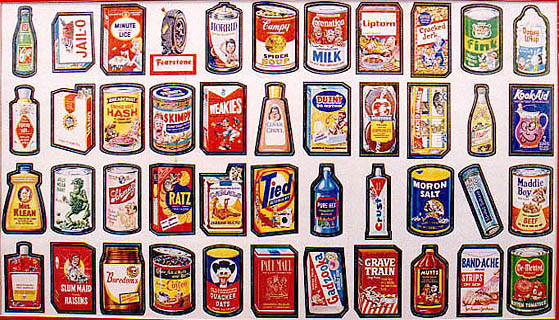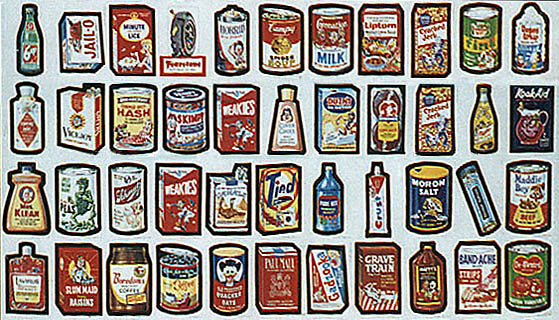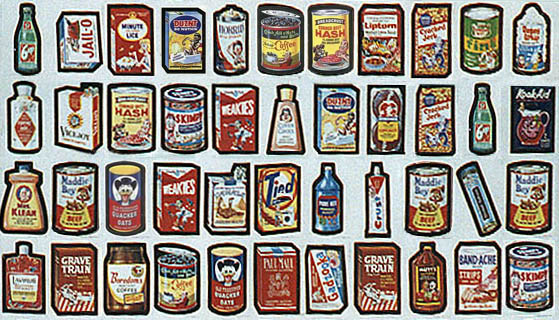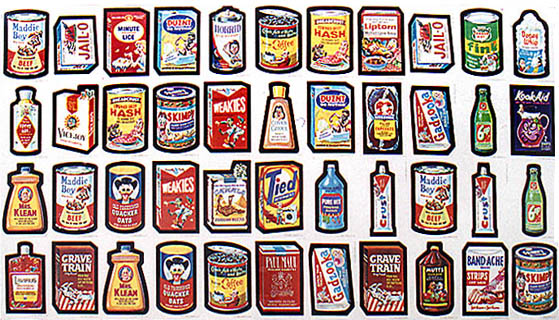
In the famous 1st series which came out in 1973, certain stickers were markedly tougher to find, creating a mix of frustration and
triumph familiar 1st series collectors. You could paper your walls
with Maddie Boys, but it was nearly impossible to find
that elusive Paul
Maul or Band-Ache. While many assumed this disparity was a
Topps marketing ploy to get kids to buy more packs, as you will see below, the unusual layout of the 1st series
uncut sheet was actually the unintended
result of six years of history.
The earliest series of Wacky
Packs was 1967's Die-Cut Series , which contained 44 titles. The 1st series
from 1973 was essentially a re-issuing of the Die-Cut series in the more convenient
peel-and-stick format. The very first Die-Cut sheet was 11 stickers across and 12 stickers high, 132 stickers, which is a perfect multiple of 44, allowing for exactly three copies of each sticker. Here is what the top four rows looked like:

There were no duplicates, each title appeared once. That didn't last for long, however. Ratz Crackers and Cracked Animals were immediately pulled due to cease and desist letters. They were replaced by a Weakies and a Cracked Jerk (because they had the most similar die-cut shapes). This led to the following top four rows of the sheet:

Due to continued cease and desists, the sheet underwent several more changes, and by the end of the Die-Cuts' run in 1968 a total of 11 titles had been pulled and replaced by duplicates. This led to the following sheet when the run ended in 1968:

Fearstone -> Duzn't
Schmutz Beer -> Quacker Oats
Campy -> Chock Full
Ratz Crackers -> Weakies
Coronation -> Breadcrust
Moron -> Jolly Mean -> Maddie Boy
Cracked Animals -> Cracked Jerk
Slum-Maid -> Grave Train
Muller Beer -> 6-Up
De-Mented -> Skimpy
Jolly Mean Giant -> Maddie Boy
The last sheet pictured above is essentially what the 1973 1st series sheet is based on, but by 1973 three more titles were off limits: Boredom's, Alcohol Seltzer, and Cracked Jerk. Alcohol Seltzer was replaced by
Crust, and Boredom's by Mrs. Klean. There were two Cracked Jerks to be replaced: the one in the first row
became Jail-O, the one in the second row became Gadzooka.
This led to the following proof version of the top four rows of the 1st series sheet:

Two final sticker position changes were made
before the final 1st series sheet was released: the 6-up from row 1 and the Maddie
Boy from row 3
are interchanged, and so are the adjacent Chock and Quacker
in row 4. Speculation has it that these
transpositions were made to ensure that duplicate stickers would
not appear within the same pack, but so far
this is just a guess. In any case, the final sheet that was released in 1973 had these top four rows.

The final change for Series 1 was the size of the uncut sheet. While the Die-Cut sheets had been 12 rows (allowing for the block of four rows to be repeated an even three times), the 1st series sheet is only 7 rows, allowing for one complete block of four rows, but only three duplicate rows. The row in which Lavirus, Paul Maul, Mutts and Band-Ache appeared was the row that was not repeated, appearing only once per sheet, while the other three rows appeared twice per sheet.
How did all this affect the number of stickers per sheet for a given title? Maddie Boy appeared six times per sheet, having replaced two removed Die-Cuts. Other designs, depending on their original position and use as replacements, appeared anywhere from two to four times per sheet. Finally, the four famous short-prints -- Lavirus, Mutts, Paul Maul and Band-Ache -- appeared only once per sheet. These are exactly the stickers from row 4 that were not used as replacements for pulled Die-Cuts! A summary of the count for each design appears in this table .
So there you have it, what started as an equal distribution of stickers
led by chance to the four short-prints that have become so notorious.
In fact, the titles which were used as replacements for pulled Die-Cuts were chosen mainly
for their shape, there was nothing special about the four
short-prints
beyond the fact that they were in the fourth row and none of them matched the shape of a pulled Die-Cut sticker closely enough to be used as a replacement. This should lay to rest 30 years of conspiracy theories about Topps marketing practices in the 70's!
Credits: Page designed and written by Dave Schmidt and Greg Grant, March, 2003.